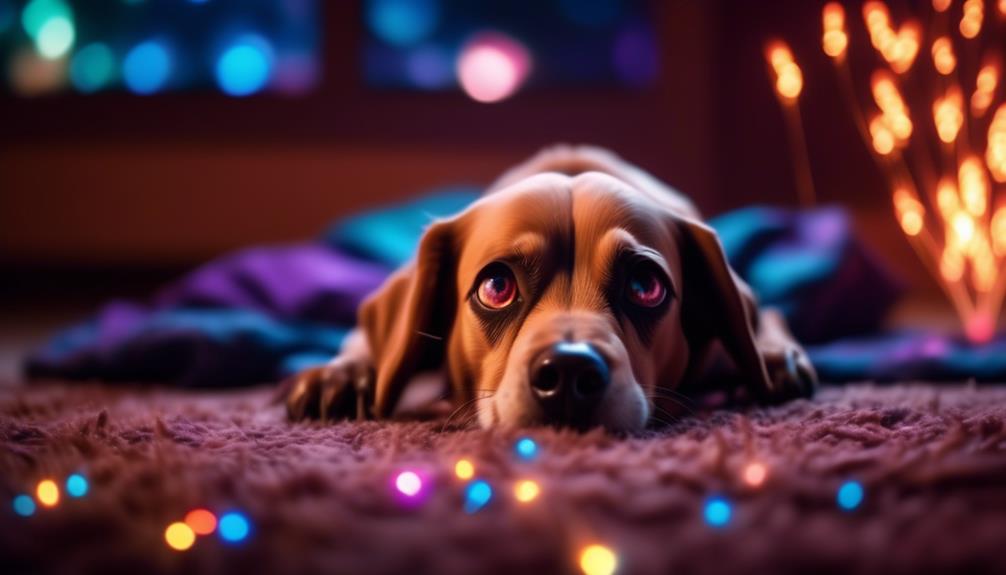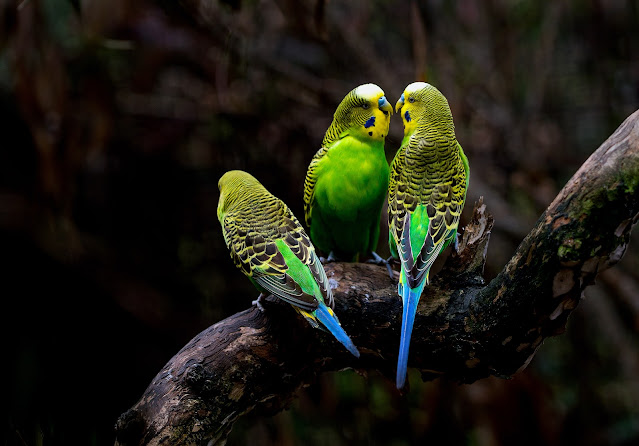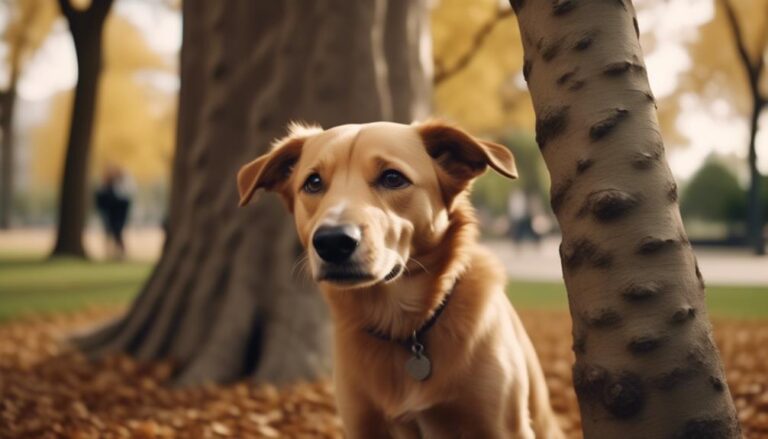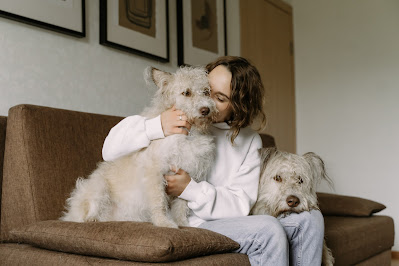Fireworks Fright: How Dogs React To Fireworks

How Dogs React To Fireworks: Did you know that approximately 45% of dogs experience fear or anxiety during fireworks? It’s a staggering number that highlights the impact of these explosive displays on our furry friends. As the loud cracks and booms fill the night sky, dogs can become overwhelmed, exhibiting a range of distressing behaviors. But why do dogs react this way, and what can we do to help them? In this discussion, we will explore the various ways dogs react to fireworks, delve into the underlying fear behind their anxiety, and discover practical strategies to support and comfort our beloved companions during these challenging times.
Common Reactions to Fireworks in Dogs
Common reactions to fireworks in dogs can vary depending on their individual temperament and past experiences. Dogs are often scared and anxious during fireworks displays due to the loud noises and bright lights. This fear response can manifest in various behaviors, including trembling, panting, pacing, and seeking comfort from their owners. Some dogs may also exhibit destructive behavior, such as chewing on furniture or attempting to escape from their surroundings. These reactions are a result of the dog’s natural instinct to seek safety and protection when faced with perceived threats.
It is important to note that not all dogs will react the same way to fireworks. Factors such as breed, age, and previous exposure to loud noises can influence their response. Some breeds, such as Border Collies and German Shepherds, are known to be more sensitive to sound and may display heightened anxiety during fireworks. Older dogs may also be more prone to fear, possibly due to age-related changes in their hearing or increased sensitivity to noise.
Dog owners must understand and recognize their pet’s reactions to fireworks. By observing their behavior and body language, owners can assess the level of distress their dog is experiencing. This can help them determine the appropriate measures to take to alleviate their dog’s anxiety.
In the next sections, we will explore effective methods for managing firework fear in dogs. These strategies include at-home counterconditioning, playing with the dog to distract them from the noise, giving treats to create positive associations, expressing positive emotions to reassure the dog, using noise CDs or pheromone diffusers to mask the sound, and implementing relaxation training or wearable pressure vests. By employing these techniques, dog owners can help their pets feel more secure and comfortable during fireworks displays.
Understanding the Fear Behind Dogs’ Fireworks Anxiety
Understanding the fear behind dogs’ fireworks anxiety requires an examination of their heightened hearing capabilities and the critical stages of development that shape their responses to loud sounds. Dogs have an extraordinary sense of hearing, capable of detecting frequencies that humans cannot perceive. In fact, dogs can hear sounds four times further away than humans, allowing them to determine which noises are significant for survival and training. This heightened auditory ability also makes them more susceptible to being startled and anxious when exposed to loud sounds like fireworks.
During their early stages of development, puppies undergo critical periods that influence their behavior and reactions to various stimuli. This includes the formation of associations during early life conditioning, which can trigger fear responses, such as the fear of loud sounds. If a puppy experiences a loud noise during this critical period and perceives it as a threat, it can lead to long-lasting anxiety and fear of similar sounds, like fireworks.
Moreover, temperament plays a significant role in a dog’s reaction to fireworks. Genetics and early development can impact a dog’s predisposition to anxiety and fear. High levels of stress experienced by a pregnant dog can potentially pass on anxiety to her offspring, making them more prone to fearful behavior, especially in response to loud noises.
Several factors also influence a dog’s fear response to fireworks, including breed, age, sex, and reproductive status. Certain breeds may be more genetically predisposed to display fearful behavior, while older dogs may be at an increased risk due to age-related changes in their hearing and cognitive abilities.
To alleviate dogs’ fireworks anxiety, there are various effective management techniques available. Prevention is key, to ensuring that dogs are kept in a safe and secure environment during fireworks displays. At-home counterconditioning can help desensitize dogs to loud noises, and tools like noise CDs, pheromone diffusers, relaxation training, and wearable pressure vests can provide calming effects.
Understanding the fear behind dogs’ fireworks anxiety is crucial to developing strategies that can help them cope with the stress and fear associated with loud noises like fireworks. By considering their heightened hearing capabilities, critical stages of development, and individual factors, we can work towards minimizing the distress experienced by our canine companions during festive occasions.
Factors That Contribute to Dogs’ Fear of Fireworks
Loud noises and vibrations, sudden bright lights, and unpredictable loud sounds are the key factors that contribute to dogs’ fear of fireworks. Dogs have a heightened sensitivity to sound, and the loud explosions and vibrations can be overwhelming for them. The sudden bright lights and unpredictable loud sounds can also startle dogs, triggering their fear response.
Loud Noises and Vibrations
The impact of loud noises and vibrations on dogs during fireworks displays can be particularly distressing, due to their heightened sense of hearing and ability to detect a wider range of frequencies. Dogs are more sensitive to vibrations and perceive them as threatening, especially when accompanied by loud sounds like fireworks. This fear response to loud noises is influenced by a dog’s early life conditioning, where associations formed during critical stages of development can trigger fear responses to similar stimuli later in life.
Additionally, genetics and stress predisposition plays a role in a dog’s fear of loud noises, as high levels of stress during pregnancy can pass on anxiety to offspring, impacting their cortisol levels and fear response. To manage firework fear in dogs, prevention and at-home counterconditioning techniques can be used, along with the use of noise CDs, pheromone diffusers, relaxation training, and wearable pressure vests to provide a calming effect during fireworks.
Sudden Bright Lights
When it comes to dogs’ fear of fireworks, another significant factor that contributes to their distress is the sudden onset of bright lights. Dogs, with their heightened senses, are more sensitive to visual stimuli, and the sudden burst of bright lights from fireworks can be overwhelming for them. This intense and unexpected visual stimulation can startle dogs and trigger fear responses.
The combination of loud noises and sudden bright lights creates a sensory overload for dogs, causing them to react in fear. It is important to understand that dogs perceive the world differently from humans, and what may seem like a beautiful display of lights to us can be terrifying for them. Managing this fear can involve strategies like creating a safe and comfortable environment, using noise CDs or pheromone diffusers, and providing dogs with wearable pressure vests to help calm their anxiety during fireworks.
Unpredictable Loud Sounds
Dogs’ fear of fireworks stems from the unpredictability of the loud sounds they produce. Canine sensitivity to sound allows them to hear more frequencies and detect sounds four times further away than humans. Their brains determine which sounds are significant, leading to stress and anxiety when confronted with loud noises like fireworks.
Early life conditioning also plays a crucial role in a dog’s fear response, as puppies undergo critical stages of development that can form associations triggering fear responses. Additionally, genetics and fear predisposition contribute to a dog’s fear of loud noises, with certain breeds and age groups being more prone to display fearful behavior. To alleviate a dog’s stress during fireworks, effective methods include prevention, at-home counterconditioning, and the use of noise CDs, pheromone diffusers, relaxation training, and wearable pressure vests.
Helping Your Dog Cope With Fireworks Fear
To help your dog cope with fireworks fear, it is important to understand the factors that contribute to their fear response. Dogs have a heightened sensitivity to sound, as they can hear a wider range of frequencies and sounds that are four times farther away than humans. Their brains are designed to determine which sounds are significant, which means loud fireworks can easily trigger anxiety. Additionally, early life conditioning plays a crucial role in a dog’s fear response. Associations formed during this time can lead to a heightened fear of loud noises like fireworks.
Genetics also play a role in a dog’s fear predisposition. Temperament is influenced by genetics and early development, and dogs can inherit anxiety from their parents. High levels of stress during pregnancy can pass on anxiety to offspring, making them more susceptible to fear of fireworks.
When it comes to managing your dog’s fear of fireworks, prevention is key. Create a safe and comfortable environment for your dog during fireworks displays. Close windows and curtains to minimize noise and flashes of light, and provide a quiet and secure space for them to retreat to. This might be a room with their favorite toys, bedding, and a familiar scent.
In addition to prevention, several techniques might help calm your dog’s anxiety. At-home counterconditioning involves gradually exposing your dog to fireworks sounds at a low volume and rewarding them for calm behavior. Noise CDs and pheromone diffusers can also be effective in creating a calming atmosphere. Furthermore, relaxation training techniques, such as deep breathing exercises and massage, might help your dog relax during fireworks displays.
Understanding the factors that contribute to your dog’s fear of fireworks and implementing these strategies can help alleviate their anxiety and create a more comfortable and peaceful experience for them.
Early Interventions for Reducing Dogs’ Sensitivity to Fireworks
To reduce your dog’s sensitivity to fireworks, there are several early interventions you can try. One effective method is noise desensitization, which involves exposing puppies to various loud noises at a young age. Additionally, using calming supplements or aids, such as wearable pressure vests, can help alleviate anxiety during fireworks displays. These interventions, along with creating a safe and comforting space for your dog, can help reduce their fear and sensitivity to fireworks.
Noise Desensitization Techniques
Exposing dogs to recorded firework sounds at increasing volumes while rewarding calm behavior can effectively desensitize them to the noise and reduce their sensitivity. This technique, known as noise desensitization, aims to modify the dog’s response to fireworks by gradually exposing them to the sound in a controlled environment. By doing so, dogs can learn to associate the noise with positive experiences, helping to alleviate their fear and anxiety.
Noise desensitization techniques involve playing recorded fireworks sounds at a low volume and gradually increasing the volume over time. During this process, it is crucial to reward the dog for remaining calm and relaxed. This positive reinforcement helps to reinforce the desired behavior and create a positive association with the noise.
It is important to note that noise desensitization techniques require time and patience. Consistency is key, as dogs may take some time to adjust to the loud noises. By implementing these techniques early on, especially during the critical period between 3 weeks and 3 months old, dogs can become less sensitive to fireworks and other loud noises later in life.
In addition to noise desensitization, creating a safe and secure space for dogs during fireworks can also help alleviate their fear and anxiety. This can be achieved by designating a special area in the home where dogs can retreat when fireworks are happening. Providing comfort through familiar items, such as their bed or favorite toys, can help dogs feel more secure.
Calming Supplements and Aids
By incorporating calming supplements and aids, such as natural calming treats, pheromone diffusers, and pressure vests, dog owners can take early interventions to reduce their dogs’ sensitivity to fireworks and prevent the development of severe firework anxiety. Calming supplements, such as chamomile or valerian root, can help relax dogs and reduce their anxiety during fireworks. Natural calming treats, formulated with ingredients like lavender or melatonin, can provide a soothing effect and promote relaxation.
Pheromone diffusers, like Adaptil, release synthetic pheromones that mimic the comforting scent produced by a mother dog, helping to create a sense of security for dogs. Pressure vests, such as the Thundershirt, apply gentle and constant pressure to dogs’ bodies, similar to the feeling of being hugged, which can have a calming effect. By using these calming supplements and aids, dog owners can help alleviate their dogs’ fireworks fright and create a more enjoyable experience for their furry friends.
Creating a Safe Space for Your Dog During Fireworks
Ensure the safety and well-being of your dog during fireworks by creating a secure and comfortable space in your home where they can seek refuge. Fireworks can cause fright and anxiety in dogs, and providing them with a designated safe space can help alleviate their stress and fear.
When creating a safe space for your dog during fireworks, consider choosing a room or area in your home that is quiet and insulated from the noise. A basement, a bedroom, or a bathroom can work well as they tend to have fewer windows and are typically more soundproof. Make sure the space is comfortable by providing your dog with their bed or blanket, as well as some of their favorite toys. This will help them feel secure and familiar in their refuge.
In addition to creating a safe physical space, it is important to use at-home counterconditioning methods to help your dog cope with the fireworks fright. Counterconditioning involves associating positive experiences with the fireworks sounds to reduce fear. Play with your dog, give them treats, and express positive emotions during the fireworks to create a positive association. This can help to change their emotional response and make the experience less distressing for them.
It is worth noting that stress genetics and fear predisposition can affect how your dog reacts to loud noises like fireworks. Some breeds may be more prone to anxiety, while others may be more resilient. Understanding your dog’s individual predispositions can help you tailor their safe space and counterconditioning techniques to their specific needs.
To prepare your dog for fireworks, gradually expose them to recorded firework sounds and reward calm behavior. Start with low volumes and gradually increase the volume over time. By doing so, you can help desensitize your dog to the noise and teach them to remain calm during fireworks.
During the fireworks display, it is crucial to stay calm and provide reassurance to your dog. Dogs are highly perceptive to their owners’ emotions, so remaining calm can help them feel more secure. Comforting them with a soothing voice, gentle petting, or even using a white noise machine or calming music can also be beneficial.
Providing Comfort and Companionship During Fireworks
To provide comfort and companionship during fireworks, it is essential to understand how your dog’s stress and anxiety can be alleviated through physical presence and reassurance. Dogs often react to fireworks with fear, anxiety, and distress. By being physically present with your dog during this time, you can offer them the comfort they need to feel safe and secure.
One way to provide comfort during fireworks is by sitting with your dog and offering physical affection. Petting and cuddling them can help soothe their nerves and provide reassurance. Speaking in a calm and soothing tone can also help to alleviate their anxiety. Your presence and touch can serve as a source of comfort and companionship during the loud noises of fireworks.
Engaging in activities that your dog enjoys can also distract them from the noise and provide companionship. Playing with their favorite toys or offering treats can help redirect their attention and create a positive association with the fireworks. This can help to ease their anxiety and provide a sense of comfort and companionship.
Creating a safe and comforting environment for your dog is another way to provide them with comfort during fireworks. This can include creating a designated hiding spot or allowing them access to their crate if they feel more secure there. By providing a safe space, you are offering them a sense of security and companionship during the stressful event.
It is important for you, as the owner, to stay calm and composed during the fireworks. Dogs can pick up on their owner’s emotions, so remaining calm and confident can help reassure your dog. Your presence, along with a calm demeanor, can provide the comfort and companionship that your dog needs during fireworks.
Distraction Techniques for Calming Dogs During Fireworks
Distraction techniques can be effective in calming dogs during fireworks by redirecting their attention and providing a sense of comfort. When dogs react to the loud noises and bright lights of fireworks, it is important to try and divert their focus onto something else. One method is to use at-home counterconditioning, which involves creating positive associations with the sound of fireworks. This can be achieved by gradually exposing your dog to recorded firework sounds at a low volume and rewarding calm behavior. By doing this over time, you can help desensitize your dog to the sounds of fireworks and reduce their fear response.
In addition to counterconditioning, other distraction techniques can be useful in calming dogs during fireworks. Playing noise CDs with calming music or natural sounds can help mask the noise of fireworks and create a more soothing environment for your dog. Pheromone diffusers, such as Adaptil, release calming scents that can help reduce anxiety in dogs. These diffusers can be plugged in near your dog’s safe area to provide a comforting atmosphere.
Relaxation training can also be beneficial in calming dogs during fireworks. Teaching your dog cues for relaxation, such as “settle” or “place,” can help them learn to calm down and find a sense of security during stressful situations. Additionally, wearable pressure vests, like Thundershirts, can provide gentle, constant pressure that can help reduce anxiety in dogs.
Creating a special safe area in your home where your dog can retreat to during fireworks is another distraction technique to consider. This area should be comfortable and include familiar items, such as their bed or blankets, toys, and treats. By providing these comforting distractions, your dog can focus on something positive and feel more secure during the fireworks.
Using Calming Products for Dogs During Fireworks
To further address the issue of calming dogs during fireworks, let’s explore the effectiveness of using calming products for dogs in such situations. Fireworks fright can cause dogs to react with fear and anxiety, and finding ways to alleviate their distress is crucial for their well-being. Calming products have been developed to help dogs cope with the stress and noise associated with fireworks.
One option is using pheromone diffusers, which release synthetic versions of calming pheromones that mimic those produced by mother dogs to comfort their puppies. These diffusers can create a sense of security and help reduce anxiety in dogs during fireworks. Additionally, noise CDs specifically designed for dogs can be utilized to desensitize them to the sound of fireworks. Gradually exposing dogs to these sounds at a low volume and rewarding them for remaining calm can help them associate fireworks with positive experiences.
Wearable pressure vests, such as Thundershirts, can also have a calming effect on dogs during fireworks. These vests apply gentle, constant pressure to the dog’s body, which may help release endorphins and create a soothing sensation. However, it’s important to note that the effectiveness of these products may vary depending on the individual dog.
Another approach to calming dogs during fireworks is early exposure to various noises, including fireworks, to desensitize them and reduce their fear response. By gradually introducing puppies to different sounds and rewarding them for calm behavior, they can develop a tolerance and become less fearful in the future.
If the use of calming products alone does not sufficiently alleviate a dog’s fear, consulting with a veterinarian or veterinary behaviorist is recommended. They can provide guidance on using prescription medications or over-the-counter calming products that may be more suitable for the specific needs of the dog.
Maintaining a Calm Demeanor to Support Your Dog During Fireworks
To support your dog during fireworks, it is crucial to maintain a calm demeanor. Demonstrating calm and relaxed behavior can help reassure your dog that there is no real danger. Dogs look to their owners for reassurance, so staying composed and avoiding showing fear or anxiety is essential. By providing a sense of security and creating a safe environment, you can help your dog cope with the stress of fireworks.
Comforting Your Dog
Maintaining a calm demeanor around your dog during fireworks can help reassure them and alleviate their stress. Dogs often react to fireworks with fear and anxiety due to their noise phobia. To comfort your dog, create a safe and secure area in your home where they can retreat.
This can be a quiet room or a crate with familiar blankets and toys. Engaging in positive activities and providing treats can also help distract and comfort your dog during fireworks. Consider using noise CDs or pheromone diffusers to create a calming environment. Relaxation training, such as teaching your dog to lie down and stay calm during loud noises, can also be effective. Additionally, wearing a pressure vest can have a calming effect on dogs during fireworks. By remaining calm and providing comfort, you can help your dog navigate the stressful experience of fireworks.
Creating a Safe Environment
Remaining calm and composed during fireworks can provide a sense of security and support for your dog. Dogs often look to their owners for reassurance, especially during stressful situations such as fireworks. By maintaining a calm demeanor, you can help your dog feel more at ease. It is important to avoid making a big fuss or showing excessive sympathy towards your dog, as this can inadvertently reinforce their fear. Instead, focus on projecting a relaxed and confident energy.
Creating a safe environment for your dog involves providing them with a secure space where they can retreat during fireworks. This could be a quiet room with familiar toys and bedding. Additionally, playing soft, soothing music or using white noise machines can help drown out the sound of fireworks, further reducing your dog’s anxiety.
How Dogs React To Fireworks Frequently Asked Questions
How Do Dogs Act When Scared of Fireworks?
When scared of fireworks, dogs may show signs of distress like barking, whining, and pacing. They can also have behavioral changes and physical reactions such as trembling and cowering. Coping mechanisms like creating a safe space are important to manage their fear and prevent long-term effects.
What Helps Dogs With Firework Anxiety?
To help dogs with firework anxiety, try natural remedies, like calming herbs. Thundershirts can be effective, providing gentle pressure that soothes them. Training techniques, noise-canceling products, and behavioral therapy should also be considered for a comprehensive approach.
Can You Desensitize Dogs to Fireworks?
You can desensitize dogs to fireworks by using desensitizing techniques, gradual exposure, positive reinforcement, calming aids, and professional help if needed. This process involves gradually introducing them to the sounds and creating positive associations to reduce fear.
What Dog Breeds Are Most Scared of Fireworks?
Certain dog breeds, like Border Collies, German Shepherds, and Labrador Retrievers, are more prone to being scared of fireworks due to their heightened sensitivity to sound.
Conclusion
In conclusion, dogs have a heightened sensitivity to fireworks due to their acute hearing and keen senses. The loud and unpredictable noises can cause fear and anxiety in dogs, leading to behaviors such as barking, trembling, and seeking hiding places. To help dogs cope with fireworks fear, owners need to create a safe and calm environment, offer distractions, and stay calm themselves. Seeking professional help and considering medication may also be beneficial for dogs with severe anxiety.








